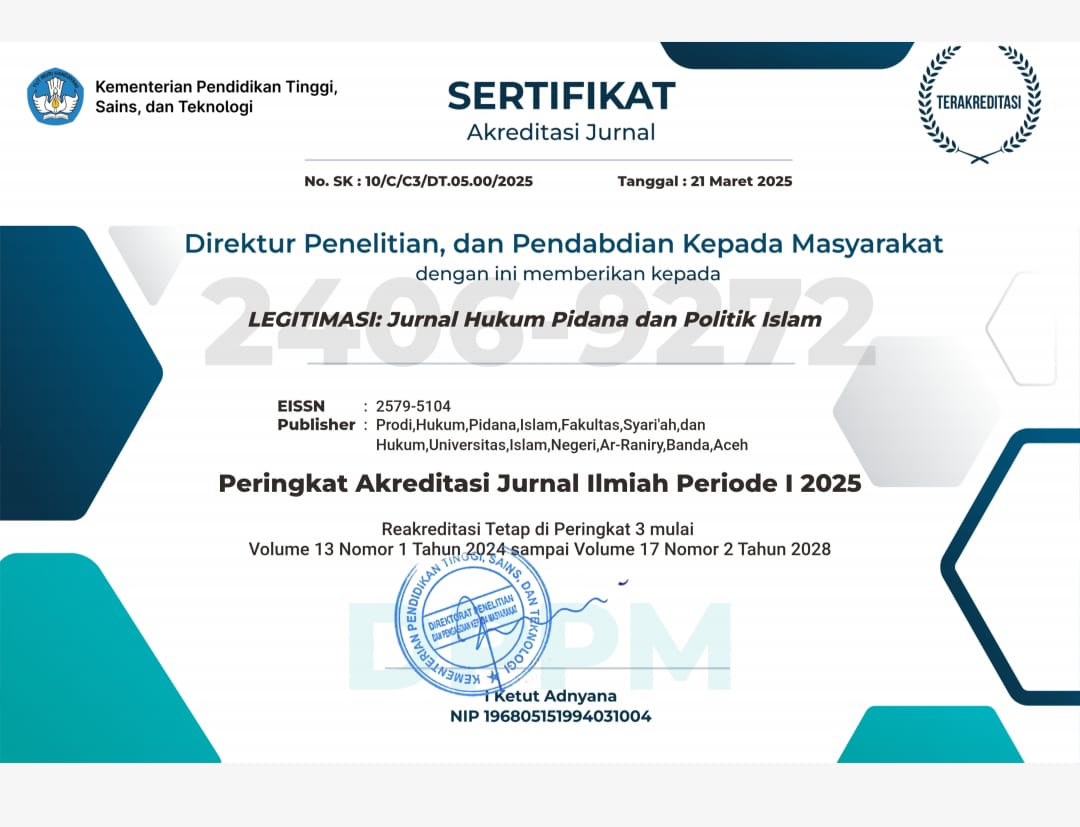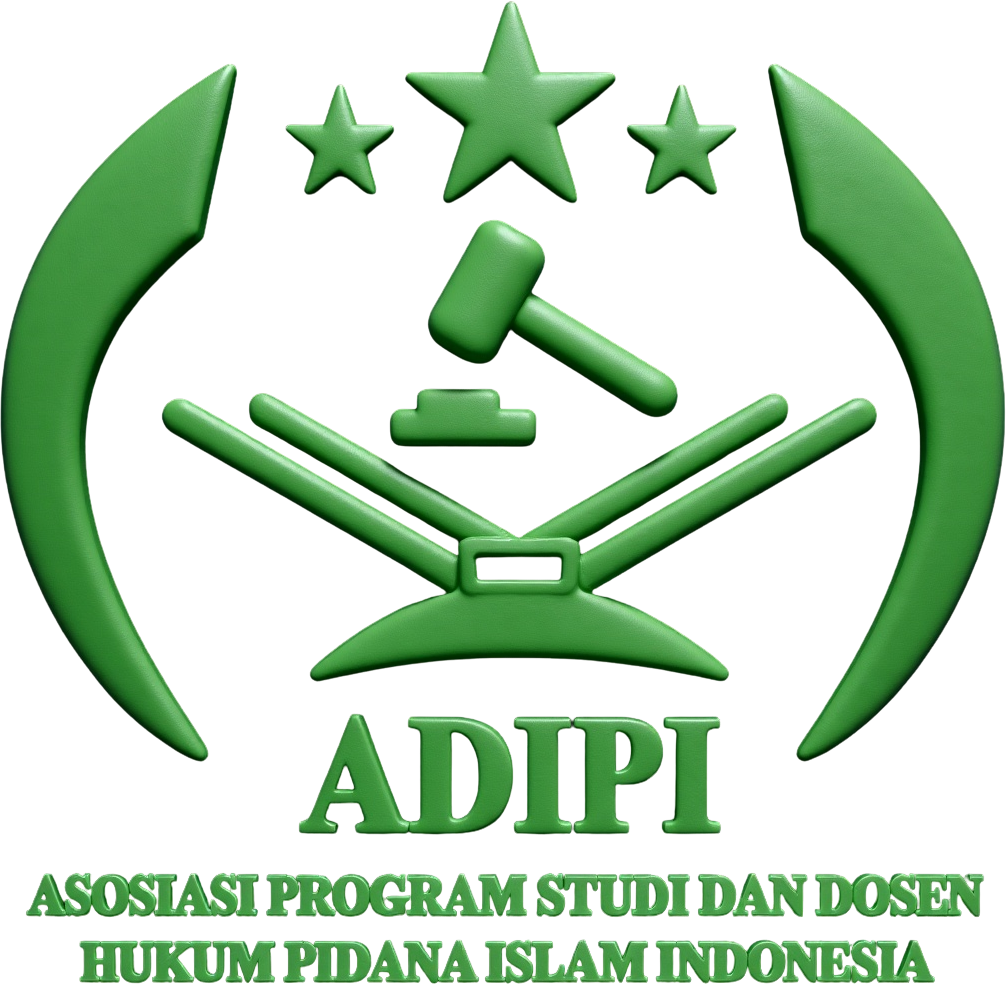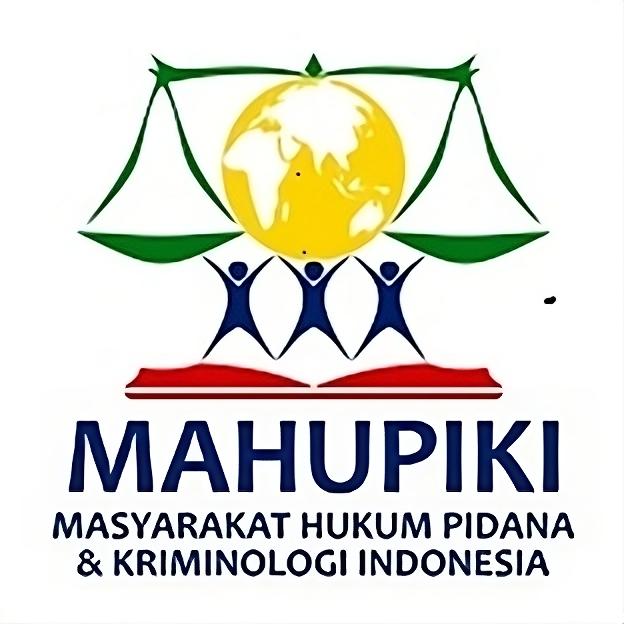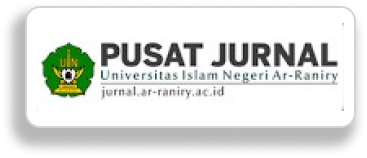Differences in the Implementation of Diversion in the Juvenile Criminal Justice System: Analysis of the Karawang Court Decision
DOI:
https://doi.org/10.22373/legitimasi.v14i1.30316Keywords:
Diversion, Juvenile Criminal Justice System, Restorative JusticeAbstract
The use of diversion in Indonesia’s juvenile justice system aims to protect children from harmful stigmatization and provide rehabilitation. The objective of the study is to analyze the application of diversion in two court decisions: Decision Number 9/Pid.Sus-Anak/2022/PN Kwg and Decision Number 14/Pid.Sus-Anak/2022/PN Kwg. The research employs a normative juridical and descriptive-analytical approach through a literature review. The findings demonstrate that the application of diversion depends on the type of offense and the condition of the child. Decision Number 9 sentenced the child to 3 years and 6 months of imprisonment for a case of child sexual intercourse, whereas Decision Number 14 imposed 120 hours of community service for theft. The analysis reveals that judicial considerations are influenced by the severity and impact of the offense, and underscore the importance of balancing law enforcement with the protection of the child’s future. This research shows that judicial discretion plays a crucial role in determining the implementation of diversion, highlighting the importance of aligning legal enforcement with restorative justice and child protection principles.
References
Adi, Koesno. Diversion in Juvenile Narcotics Crimes. Malang: Setara Press, 2015.
Agnesta, Krisna Liza. Child Protection Law. Yogyakarta: Deepublish, 2016.
Badu, Lisnawaty W., and Julisa Aprilia Kaluku. “Restorative Justice in The Perspective of Customary Law: A Solution to The Settlement of Narcotics Crimes Committed by Children.” Jambura Law Review 4, no. 2 (2022).
Dakua, Tushar, Margubur Rahaman, and K. C. Das. “An Analysis of the Spatial and Temporal Variations of Human Trafficking in India.” Cogent Social Sciences 10, no. 1 (2023).
Dewim, Aida., Fifink Praiseda Alviolita Fuad. “The Application of Diversion for Juvenile Theft Committed Alongside Adults.” Jurnal Yudisial 15, no. 3 (2022).
Dwijayanti, Mita. “Diversion for Juvenile Recidivism,” Rechtidee Jurnal Hukum 12, no. 2 (2017): 225.
Firman Zakaria, Chepi Ali, Ade Mahmud, and Aji Mulyana. “Legal Protection for Child Victims of Sexual Assault in a Restorative Justice Perspective.” Jurnal Penelitian Hukum De Jure 23, no. 1 (2023).
Ghoniand, Mahendra Ridwanul, and Pujiyono Pujiyono. “Perlindungan Hukum Terhadap Anak Yang Berhadapan Dengan Hukum Melalui Implementasi Diversi Di Indonesia.” Jurnal Pembangunan Hukum Indonesia 2, no. 3 (2020).
Hadi, Sulaksono. Application of Diversion Principles in Juvenile Theft Cases at Sleman District Court. Yogyakarta, 2016.
Hidaya, Wahab Aznul. “The Implementation of Diversion in the Juvenile Justice System,” Justisi 5, no. 2 (2019): 86–87.
Hidayat, Syahriful Khaerul., Hijrah Adhyanti Mirzana, and Dara Indrawati. “The Urgency of Implementing Diversion for Juveniles Involved in Narcotics Crimes.” 5, no. 2 (2021).
Hirdayadi, Israr, and Hera Susanti. “Diversi Dalam Sistem Peradilan Pidana Anak Di Indonesia Dan Tinjauannya Menurut Hukum.” LEGITIMASI: Jurnal Hukum Pidana Dan Politik Hukum 6, no. 2 (2017).
Hutahaean, Bilher. “Penerapan Sanksi Pidana Bagi Pelaku Tindak Pidana Anak Kajian Putusan Nomor 50/Pid.B/2009/PN.Btg IMPoSING.” Jurnal Yudisial 6, no. 1 (2013).
Listyarini, Dyah. “Juvenile Justice System Through Diversion And Restorative Justice Policy.” Diponegoro Law Review 2, no. 1 (2017).
Manthovani, Reda. et al., Restorative Justice in the Practice of Criminal Case Handling in Indonesia. Jakarta: Publica Indonesia Utama, IKAPI, 2023), 93.
Mitskaya, Elena. “Theoretical Thoughts on Legal Regulation of Mediation in Criminal Process in Kazakhstan.” International Journal of Criminal Justice Sciences 15, no. 1 (2020).
Muhammad, Rusli. Sistem Peradilan Pidana Anak Indonesia. Yogyakarta: FH UII Press, 2022.
Nashriana, Desia Rakhma Banjarani, Marwin S. Del Rosario, and Vera Novianti. “Enhancing Restorative Justice in Indonesia: Exploring Diversion Implementation for Effective Juvenile Delinquency Settlement.” Sriwijaya Law Review 7, no. 2 (2023).
N., & Rahmiati, R. Nurhafifah. “Judges’ Considerations in Sentencing Regarding Aggravating and Mitigating Factors.” Kanun Jurnal Ilmu Hukum 17, no. 2 (2015).
Pasemah, Gerry Rizky Putra El. Guide to Diversion in the Juvenile Justice System in Indonesia. Jakarta: Class 1 Correctional Guidance Center.
Purwati, Ani. Restorative Justice and Diversion in the Resolution of Juvenile Criminal Cases. Surabaya: Jakad Media Publishing, 2020.
Prakoso, Abintoro. Pembaharuan Sistem Peradilan Pidana Anak. Yogyakarta: Laksbang Grafika, 2013.
“Putusan_14_pid.Sus-Anak_2022_pn_kwg_20250219002955,” n.d.
“Putusan_9_pid.Sus-Anak_2022_pn_kwg_20250319130043,” n.d.
Rahman, Faiz. “Contextualizing Restorative Justice Through Diversion Mechanism: A Study Of Indonesia’s Juvenile Justice System.” Indonesia Law Review 9, no. 3 (2019).
Rizanizarli, Rizanizarli, Mahfud Mahfud, Riza Chatias Pratama, and Fikri Fikri. “The Application of Restorative Justice for Children as Criminal Offenders in the Perspective of National Law and Qanun Jināyat.” Samarah 7, no. 1 (2023).
Rochaeti, Nur, and Nurul Muthia. “Socio-Legal Study of Community Participation in Restorative Justice of Children in Conflict with the Law in Indonesia.” International Journal of Criminology and Sociology 10 (2021).
Saidah. “Counterproductive of Diversion for Children in Conflict with the Law: The Context of Legal Imposition from the Perspective of Islamic Law.” Russian Law Journal 11, no. 3 (2023).
Sánchez, Paula Miranda, Jorge Farah, Daniela Bolívar, Bianca Baracho, and Marcela Fernández. “Restorative Juvenile Penal Mediation in the Framework of the New National Youth Social Reintegration Service in Chile: Principles and Foundations of a Technical Standard.” Politica Criminal 17, no. 33 (2022).
Sliva, Shannon M., and Mark Plassmeyer. “Effects of Restorative Justice Pre-File Diversion Legislation on Juvenile Filing Rates: An Interrupted Time-Series Analysis.” Criminology and Public Policy 20, no. 1 (2021).
Sosiawan, Ulang Mangun. “Perspektif Restorative Justice Sebagai Wujud Perlindungan Anak Yang Berhadapan dengan Hukum (Perspective of Restorative Justice as A Children Protection Against The Law).” Jurnal Penelitian Hukum De Jure 16, no. 4 (2017).
Sudewo, Fajar Ari, Hamidah Abdurrachman, and Fajar Dian Aryani. “The Application of Restorative Justice System through the Diversion of Children in Conflict with Laws in Central Java Polda (Regional Police of the Republic of Indonesia).” International Journal of Psychosocial Rehabilitation 24, no. 2 (2020).
Sulistyo, Edhei, Pujiyono, and Nur Rochaeti. “Restorative Justice as a Resolution for the Crime of Rape with Child Perpetrators.” International Journal of Criminology and Sociology 10 (2021).
Sumardi, Dedy, Ratno Lukito, and Moch Nur Ichwan. “Legal Pluralism within the Space of Sharia: Interlegality of Criminal Law Traditions in Aceh, Indonesia.” Samarah 5, no. 1 (2021): 426–49.
Sumardi, Dedy, Mansari Mansari, and Maulana Fickry Albaba. “Restoratif Justice, Diversi Dan Peradilan Anak Pasca Putusan Mahkamah Konstitusi Nomor 110/Puu-X/2012.” Legitimasi: Jurnal Hukum Pidana Dan Politik Hukum 11, no. 2 (2022): 248–65.
Susanti, Hera. “Diversion in the Juvenile Criminal Justice System in Indonesia and Its Review from the Perspective of Islamic Law,” no. 2 (2017): 180.
Wiyono. Juvenile Criminal Justice System in Indonesia. Jakarta: Sinar Grafika, 2016.
Yunus, Yutirsa. “Analisis Konsep Restorative Justice Melalui Sistem Diversi dalam Sistem Peradilan Pidana Anak di Indonesia.” Jurnal Rechts Vinding: Media Pembinaan Hukum Nasional 2, no. 2 (2013).
Statute
Criminal Code of Indonesia (Kitab Undang-Undang Hukum Pidana).
Law of the Republic of Indonesia Number 17 of 2016 on the Stipulation of Government Regulation in Lieu of Law Number 1 of 2016 on the Second Amendment to Law Number 23 of 2002 on Child Protection.
Law of the Republic of Indonesia Number 11 of 2012 concerning the Juvenile Criminal Justice System (JCJS).
Supreme Court Regulations (Peraturan Mahkamah Agung) Number 4 of 2014 on Guidelines for Diversion in the Juvenile Criminal Justice System.
Downloads
Published
Issue
Section
License
Copyright (c) 2025 Rini Nuraeni, Muhammad Gary Gagarin Akbar, Muhamad Abas

This work is licensed under a Creative Commons Attribution-NonCommercial-ShareAlike 4.0 International License.
Authors who publish in Legitimasi: Jurnal Hukum Pidana dan Politik Hukum agree to the following terms:
- Authors retain copyright and grant the journal right of first publication with the work simultaneously licensed Attribution-ShareAlike 4.0 International (CC BY-SA 4.0) that allows others to share the work with an acknowledgment of the work's authorship and initial publication in this journal.
- Authors are able to enter into separate, additional contractual arrangements for the non-exclusive distribution of the journal's published version of the work (e.g., post it to an institutional repository or publish it in a book), with an acknowledgment of its initial publication in this journal.
- Authors are permitted and encouraged to post their work online (e.g., in institutional repositories or on their website) prior to and during the submission process, as it can lead to productive exchanges, as well as earlier and greater citation of published work. (See The Effect of Open Acces)












